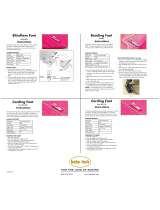
T
A
B
L
E
O
F
C
O
N
T
E
N
T
S
3
Table of Contents
OVERVIEW................................................................................................................ 5
How Your Acclaim Operates ............................................................................. 5
Overview of the Acclaim ................................................................................... 6
Accessories ...................................................................................................... 7
Needles............................................................................................................. 8
Thread .............................................................................................................. 8
Optional Accessories ........................................................................................ 8
Setting Up Your Acclaim ................................................................................... 9
Cutting Blade Locking Dial ..............................................................................10
Thread Cutter...................................................................................................10
Presser Foot Pressure Adjustment..................................................................10
Snap-On Presser Foot.....................................................................................10
Stitch Length / Rolled Hem ............................................................................. 11
Stitch Width..................................................................................................... 11
Differential Feed ............................................................................................. 12
Thread Delivery System ................................................................................. 13
Stitch Selector Lever....................................................................................... 13
Wave/Overlock Selector Lever ....................................................................... 13
Upper and Lower Looper Thread Fine-Tuning Knob ...................................... 13
2-Thread Subsidiary Looper .......................................................................... 14
Looper Air Threading System ......................................................................... 15
Needle Air Threading System ......................................................................... 15
Side Cover ..................................................................................................... 15
Notes ............................................................................................................. 16
THREADING............................................................................................................ 17
Threading Preparation.................................................................................... 17
Threading Your Acclaim.................................................................................. 18
Threading Position for Threading ................................................................... 18
Lower Looper.................................................................................................. 18
Upper Looper.................................................................................................. 19
Right Needle................................................................................................... 20
Left Needle ..................................................................................................... 20
How to Use RevolutionAir Needle Threader................................................... 21
Needle Threading Mode ................................................................................. 22
RevolutionAir Needle Threading Guide .......................................................... 22
Sewing with fabric........................................................................................... 23
Clearing the Stitch Width Fingers ................................................................... 23
Re-threading Loopers..................................................................................... 24
Re-threading Needles..................................................................................... 24
4-THREAD OVERLOCK ......................................................................................... 25
4-Thread Overedging ..................................................................................... 25
Overlock Seam ............................................................................................... 25
4-Thread Overlock.......................................................................................... 26
3-THREAD OVERLOCK ......................................................................................... 27
3-Thread Overlock - Wide............................................................................... 27
3-Thread Overlock - Narrow ........................................................................... 28
3-Thread Overlock - Narrow Hem................................................................... 29
Rolled Edging ................................................................................................ 30
3-Thread Rolled Edge ................................................................................... 30
Seaming Sheers ............................................................................................. 31
Lettuce Edge .................................................................................................. 31
Belt Loops and Button Loops.......................................................................... 31
Returning to Standard Serging ....................................................................... 31
3-Thread Flatlock ........................................................................................... 32





















